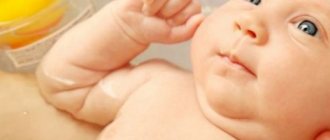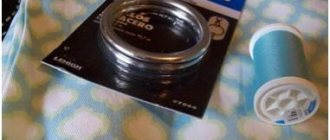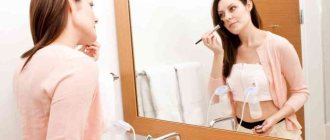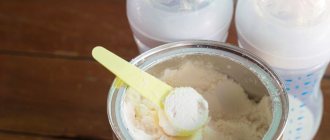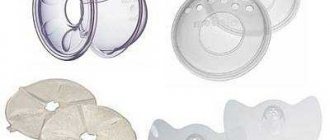VK
Buffer
There is a lot to be said about the benefits and value of breastfeeding. However, not all women can boast of a pleasant experience of this process. Many suffer from pain and because of this they resort to a modern invention - breast pads for feeding. What are breastfeeding shields?
Special attachments made of latex or silicone are designed in such a way that they fit under any breast shape. The composition of the material used is safe and does not harm the health of the child. Breastfeeding pads are designed to make breastfeeding easier. They are used when a woman, due to physiological or other reasons, cannot feed naturally.
In what cases are overlays used?
There are many opinions about whether or not attachments should be used. Many doctors advise using this device only in extreme cases:
- Initial stage of lactation. In the first days of the postpartum period, young mothers encounter painful sensations during feeding, which are associated with improper attachment of the child to the breast.
- Baby's refusal to breastfeed. If a baby has been bottle-fed with formula or milk for a long time, he may refuse to latch on to the breast. This happens because it is easier to eat from a bottle. When breastfeeding, the baby spends some effort to get milk. Modern breast pads for feeding are similar in shape and quality to a bottle nipple. In order to wean a baby to the breast, the use of such attachments is considered acceptable.
- Any damage to the nipple that causes unbearable pain while breastfeeding.
- Birth injuries. If a child has these, the process of functioning of the nervous system may be slowed down, which is why the baby sucks the breast incorrectly. To teach sucking, feeding attachments or false breasts are often used.
- If your child is teething. At this time, children's behavior is very restless and capricious. During this period, the gums are very itchy, and babies often do this on their mother’s nipple. Biting the nipple during feeding causes discomfort and sharp pain. Women have to use attachments in such cases.
- Non-standard nipple structure. Various physiological abnormalities of the nipples occur: non-standard size, elongation, flatness, etc.
If you have the above problems, you should try to solve them without using pads and only if the problem cannot be solved, use them.
Disadvantages of using breastfeeding shields
Many studies by specialists in this field have revealed the following:
- The psychological contact between mother and child decreases, which causes a decrease in the amount of milk produced. This happens due to a disruption in the functioning of oxytocin, which relaxes the milk flow.
- A woman spends more time feeding. Not all of the sucked milk reaches the baby; some of it leaks, and in order for the baby to eat the required dose, you need to keep him at the breast for much longer than with normal feeding.
- When using a chest attachment, the baby often swallows air, which entails undesirable consequences: abdominal cramps, regurgitation, bloating.
- Violation of the sucking mechanism. No matter how thin the material from which the nipple covers are made, the baby’s sucking intensity is disrupted. This happens especially often during the decline of lactation.
- Breast attachments are inconvenient to use for feeding outside the home, as well as at night.
- Those women who use breast pads for a long time are more likely to suffer from mammary candidiasis.
How to choose the right breast pads?
There are many manufacturers of breastfeeding pads: Avent, Medela, World of Childhood, etc. Even the most experienced mothers can get confused by the variety of companies. When choosing nozzles, consider the following:
- Some breast attachments (for example, Avent, Medela, Chico) differ in sizes S/M/L. The sizes differ according to the diameter of the nipple. S is less than one centimeter, M is one centimeter and L is more than one centimeter.
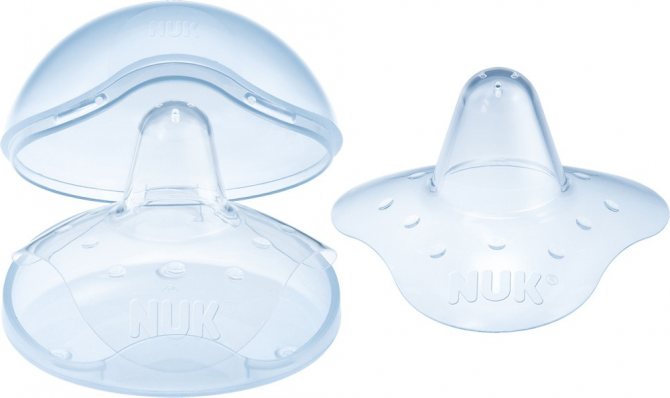
- Each of the overlays has a base. It is necessary to pay attention to the shape of the base, which comes with one or two recesses. Women try to choose a base shape so that the baby's nose can feel the mother's breasts.
- It is very important to pay attention to the shape of the nipple shield. It should be significantly higher than the mother's nipple. During feeding, the woman's nipple increases in size and is pressed against the nozzle. During feeding, the nipple should fill the entire cavity of the pad, but if this does not happen, it is too large.
- Silicone pads are one of the most popular today. This is due to the fact that they are odorless, very thin and hypoallergenic.
Each person individually chooses a manufacturer of pads based on the physiological characteristics of the child and mother, as well as the financial situation of the family, since the cost of these products has a wide range of prices.
When their use is necessary
Sometimes a doctor prescribes breastfeeding pads, because there are a number of situations when you can’t do without them:
- For very severe pain that occurs during feeding. Especially if this was the woman’s first pregnancy. Nipple cracks heal slowly, and in combination with a low pain threshold, they can lead to the mother’s refusal to breastfeed. Therefore, in order not to switch your baby to formula, you need to use pads.
- If the baby has a short frenulum of the tongue. Because of this, his tongue takes an active part in the feeding process, but cannot properly grasp the nipple. This causes difficulty in the lactation process. Therefore, in order not to cut the frenulum, the mother uses overlays.
- If the baby belongs to the category of “special” children: born prematurely, has a weak central nervous system. In such newborns, the process of sucking and swallowing is impaired, so they do not receive enough breast milk in the required volume. But the pads help to cope with this problem and not transfer the baby to formula.
- If the baby has been drinking milk from a bottle for some time, it is likely that he will get used to the nipple and will refuse his mother's breast. In this case, a breast shield will help resume the process of breastfeeding.
In all of these situations, breastfeeding shields make lactation easier. This also allows you not to transfer the baby to artificial nutrition too early. For pregnant and nursing mothers, the price of goods in our pharmacy is low.
How to properly feed with a breastfeeding shield
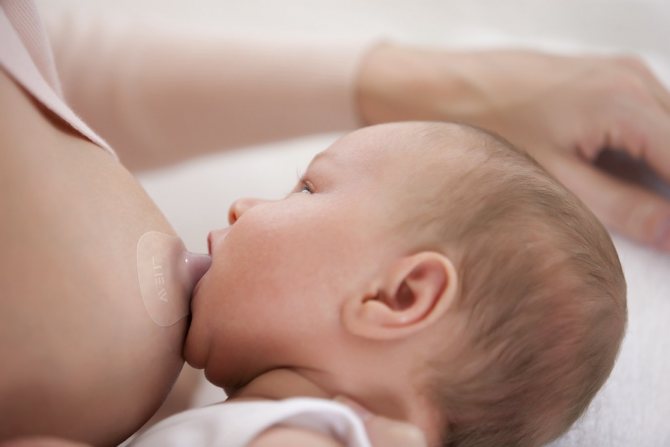
If the situation is such that the use of attachments for breastfeeding is necessary, you should adhere to certain rules:
- First of all, you need to boil the pad.
- Before use, you need to moisten the inside of the pad with a few drops of expressed milk or boiled water. This helps it adhere to the breast and thereby ensures convenience during feeding.
- After this, you need to turn the edges of the nozzle as far as possible and attach it to the nipple so that it fits completely into the artificial one.
- The final stage is to firmly press the edges of the pad to the chest.
It does not matter how breastfeeding occurs - with or without a pad, proper attachment of the baby is the basic rule of good feeding, which will avoid painful sensations. It is also necessary to carefully monitor the position of the lining itself, making sure that it does not move.
Indicators of successful feeding through the nozzle are the feeling of a rush of milk in the mother within a few minutes after the start of feeding, as well as the frequency of the baby’s stool and weight gain.
The absence of milk stagnation is also a sign that the breast is completely empty.
Feeding should only be completed at the baby’s initiative. You need to wait for the moment when he releases the nipple.
How to wean your baby off feeding using pads
Long-term use of pads leads to the fact that the baby refuses to latch on to the breast. The weaning process is no less important than the correct choice of product. Usually it takes 2 weeks, in some cases - a month. The less and less frequently a product is used, the easier it will be to discard it.
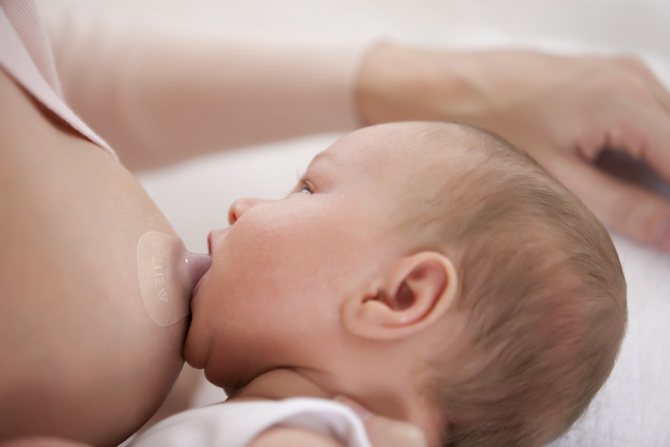
To help your child break the habit of eating with pads, use the following tips:
- Try to feed your baby while he is sleepy or just waking up. At this time, the likelihood that the child will not notice the absence of the nozzle increases.
- During feeding, remove the attachment as quickly as possible and offer the breast to your baby.
- Cut a small piece of silicone from the product every day. This will increase the area of contact between the baby and the mother’s mammary gland and gradually wean him off feeding using the breastplate.
- You can supplement your baby with expressed milk from a bottle with a nipple or from a pipette. Before and after feeding, you must offer him the breast.
- It is recommended to spend more time with your child. Frequent contact with the mother's body will allow the baby to quickly get used to the breast.
Doctors recommend using devices to facilitate breastfeeding only when necessary to avoid negative consequences and addiction.
Main types of breast pads
There are three types of breast pads:
- Rubber. Today there are very few of them on sale and doctors do not recommend their use. They are identical to bottle nipples, but are attached to a plastic base. Sometimes there is also a glass base. There are many disadvantages of this design: the baby is far from the mother’s breast, poor stimulation of the nipple, frequent leakage occurs, which prevents the baby from receiving the required amount of milk.
- Latex. Not particularly popular, despite the softness of the material. Such products have a yellow tint. They do not have wear resistance and absorb foreign odors. They also have their own specific smell and often cause allergies in infants.
- Silicone. Today - the most relevant and safe. They are hypoallergenic and do not wear out quickly. The thin material allows the nipple to be stimulated during feeding, which promotes good milk production.
Large selection of nursing pads here. Choose!
Storing Breast Pads
Hygiene is a basic rule that applies to any contact with a child. Before using breastfeeding pads for the first time, you should wash them under running water. Then they should be placed in a container, filled with cold water and put on fire. It is very important that the linings do not come into contact with the walls of the container in which boiling occurs. After the water boils, you need to wait three to four minutes and only then remove from the stove. Having taken the pads out of the water, place them on a dry, clean towel, cover them on top and wait until they dry. This procedure is performed only before the first use. There is no need to do this every time after feeding, as the material may become rough.
After the next use of the pads, they must be rinsed with warm water and dried on a dry towel. The attachments are stored either in special containers or on a towel covered on top.
Proper use and storage of the pads ensure a long service life.
Recommendations for their use

Breastfeeding shields are not a must-have item that every breastfeeding mom should have. If the doctor decides that their use is necessary, then after solving the problem the baby needs to be weaned off them. To do this, the mother should put the newborn to the breast during sleep or quickly remove the device during feeding.
You can also make using the pads uncomfortable for your baby. And you shouldn’t start using them without an objective reason. If the child does not have difficulty feeding, gains weight, and the mother does not experience discomfort, then these products are not needed.

